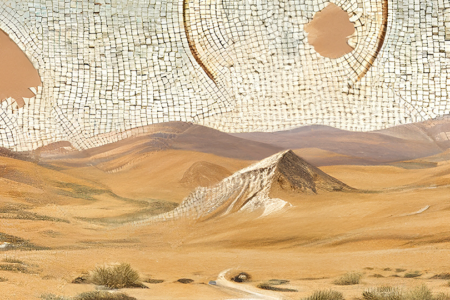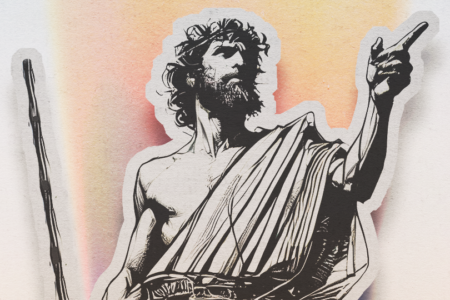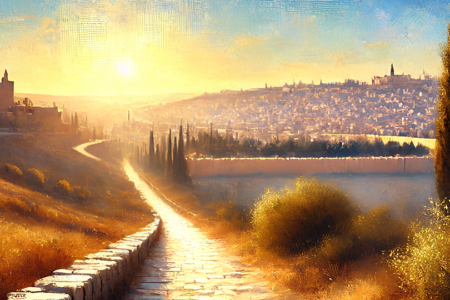DISCOVERY of the SCROLLS
Juma was beginning to get nervous. Some of the goats he had been tending were climbing too high up the cliffs. He decided to show his own nimbleness and climb the cliff face himself to bring them back. Little did Juma realize as he began his climb on that January day in 1947 that those straying goats would eventually involve him in “the greatest archaeological discovery in the twentieth century”. Such thoughts were far from his mind, however, when he saw two small openings to one of the thousands of caves that dot these barren cliffs that overtook the northwestern shore of the Dead Sea. He threw a rock into one of the openings. The rock had broken pottery; what else would be in those remote caves but treasure? He called to his cousins, Khalii and Muhammad, who climbed up and heard the excited tale. But it was getting late, and the goats had to be gathered. Tomorrow they would return ~ perhaps their days of following the goats would soon be over.
However, the youngest of the three, Muhammad, rose the next day before his two fellow treasure-seekers and made his way to the cave. The floor was covered with debris including broken pottery. Along the wall stood a number of narrow Jars, some with their bowl-shaped covers still in place. Frantically, Muhammad began to explore the inside of each jar. But no treasure of gold was to be found; onty a few bundles wrapped in cloth and greenish with age. Returning to his cousins, he related the “sad” news—no treasure! No treasure indeed! The scrolls that those Bedouin boys removed from that dark cave that day and in the days following would come to be recognized as the greatest manuscript treasure ever found — the first seven manuscripts of the Dead Sea Scrolls!
Such was the discovery of a group of manuscripts a thousand years older than the oldest known Hebrew texts of the Bible, manuscripts many of which were written more than a hundred years before the birth of Jesus. Manuscripts that would excite the archaeological world and provide a team of translators with a gigantic task that even to this day has not been completed.
The story of how those scrolls traveled from the hands of young Bedouin goatherders to be under the scrutinous eyes of international scholars is stranger than fiction. Although all the details of the next few years will probably never be known for sure, this much is clear. After a period of time hanging from a pole in a Bedouin tent, the seven original scrolls were sold to two separate Arab antiquities dealers in Bethlehem. From there four were sold to Athanasius Samuel, Syrian Orthodox Metropolitan at St. Mark’s Monastery in the Old City of Jerusalem. Scholars at the American School of Oriental Research were able to examine them and were the first to realize their antiquity. John Trever photographed them in detail, and the great archaeologist, William Albright, assuredly announced that the scrolls were from the period between 200 B.C. and 200 A.D. The initial announcements were made that the oldest manuscripts ever discovered had been found in the Judean desert!
Three other of the original scrolls found by the Bedouin boys were sold to E.L. Sukenik, archaeologist at the Hebrew University and the father of Yigal Yadin, an officer in the Jewish army who later became quite a famous archaeologist. It should be noted that the drama of these events was heightened because these were the last days of the British Mandate period in Palestine, and tensions between the Arab and Jewish population were great. This made examination of the scrolls by scholars extremely dangerous.
All of the scrolls finally came together at the Hebrew University under another strange set of circumstances. After touring the United States with his four scrolls and not being able to find an interested buyer, Metropolitan Samuel placed an ad in the Wall Street Journal. In February 1955 the Prime Minister of Israel announced that the State of Israel had purchased the scrolls and all seven (including the three purchased by Professor Sukenik) were to be housed in a special museum at the Hebrew University named the Shrine of the Book, where they can be seen today.
Needless to say, the initial announcement about the scrolls prompted feverish searches in the area of the original discoveries. An official archaeological expedition was begun in 1949 which has eventually resulted in discovering ten additional caves in the surrounding area that also contained scrolls. The archaeologists also directed their attention to a small ruin nearby called “Khirbet Qumran”, which had been thought of as the remains of the old Roman fortress. After six seasons of intensive excavation, the scholars were sure beyond any reasonable doubt that the scrolls found their origin in this community which flourished between approximately 125 B.C. and 68 A.D. The scrolls were stored in haste in the caves as the community fled the encroaching Roman army, which was in Judea to put down the Jewish Revolt of 66-70A.D.
The ruins of Qumran, which can be visited today, reveal that a substantial group of Jewish ascetics inhabited this community. Storehouses, aqueducts, ritual baths, and an assembly hall were all uncovered. One of the most interesting rooms uncovered was a scriptorium, identified by the discovery of two inkwells along with some benches for scribes. It was in this room that many, if not all, of the manuscripts were copied.
Description of the Scrolls
As soon as the announcement was made of the scrolls’ discovery, the scholarly debates about their origin and significance began. The debates increased when the amazing contents of the scrolls were successively revealed.
The seven original scrolls from what came to be called “Cave One” comprised the following: (1) a well-preserved copy of the entire prophecy of Isaiah — the oldest complete copy of an Old Testament book ever to be discovered; (2) another fragmentary scroll of Isaiah; (3) a commentary on the first two chapters of Habakkuk — the commentator explained the book allegorically in terms of the Qumran brotherhood; (4) the “Manual of Discipline” or “Community Rule” is the most important source of information about the religious sect of Qumran (it described the “requirements” for those aspiring to join the brotherhood); (5) the “Thanksgiving Hymns”, a collection of devotional “psalms” of thanksgiving and praise to God; (6) an Aramaic paraphrase of the Book of Genesis; (7) the “Rule of War” dealt with the battle between the “Suns of Light” (the men of Qumran) and the “Sons of Darkness” (the Romans?) which would take place in the “last days”, which days the men of Qumran believed were about to arrive.
Those seven original scrolls were Just the beginning. Over six hundred scrolls and thousands of fragments have been discovered in the eleven caves of the Qumran area. Fragments of every biblical book but Esther have been found as well as many other non-biblical texts, One of the most fascinating was a copper scroll which had to be cut in strips to be opened, and which contained a list of sixty treasures located in various parts of Judea (none of which have been found)!
The contents of the Dead Sea Scrolls indicate that their authors were a group of priests and laymen pursuing a communal life of strict dedication to God. Their leader was called “the Righteous Teacher”. They viewed themselves as the only true “elect” of Israel — they alone were faithful to the Law. They opposed the “Wicked Priest”, who was probably the Jewish High Priest in Jerusalem, who represented the “establishment” and who had persecuted them in some way. Most scholars have identified the Qumran brotherhood with the “Essenes”, a Jewish sect of Jesus day described by Josephus and Philo.
Whoever the men of Qumran were, their writings provide us with a marvelous background picture of one aspect of the religious world into which Jesus came. Some have sought to draw parallels between figures in the scrolls and John the Baptist or Jesus, but an objective examination of such parallels reveals that the differences are greater than the similarities. Any contact of Jesus with Qumran is entirely speculative and most improbable. The suggestion that John the Baptist may have spent some time with the Qumran community is possible, since the Gospels tell us that he spent considerable time in “the wilderness”, the area where the Qumran community is located (Mt. 3:1-3; Mk. 1:4; Lk..1:80; 3:2, 3). John’s message, however, differed markedly from that of the Qumran brotherhood. The only real common point was that they both taught that the kingdom of God was coming.
One of the most important contributions of the Dead Sea Scrolls is in the numerous biblical manuscripts which have been discovered. Up until those discoveries at Qumran, the oldest manuscripts of the Hebrew Scriptures were copied in the ninth and tenth centuries A.D. by a group of Jewish scribes called the “Masoretes”. Now we have manuscripts around a thousand years older than those. And the amazing truth is that they are almost identical! Here is a strong illustration of the tender care of the Jewish scribes down through the centuries in accurately copying the sacred Scriptures. We can have confidence that our Old Testament Scriptures faithfully represent the words given to Moses, David and the prophets.
Doctrine of the Scrolls
The men of Qumran fervently believed in a doctrine of “last things” . They had fled to the desert and were readying themselves for the imminent judgment when their enemies would be vanquished and they, God’s elect, would be given final victory in accordance with the prediction of the prophets. It was in connection with these “endtime” events that one of the most fascinating teachings of the sect emerges. The “Messianic Hope” loomed large in the thought of the brotherhood. As a matter of fact, the evidence shows that they actually believed in three “Messiahs” — one a prophet, another a priest and the third a king or prince.
In the document mentioned earlier called the “Manual of Discipline” or the “Rule of the Community”, it is laid down that the faithful should continue to live under the rule “until the coming of a prophet and the anointed ones (Messiahs) of Aaron and Israel” (column 9, line 11). These three figures would appear to usher in the age for which the community was making preparation.
In another document found in Cave Four and referred to as the “Testimonia”, a number of Old Testament passages are brought together which formed the basis for their messianic expectations. The first is the citation from Deuteronomy 18:18, 19 where God says to Moses: “I will raise up a prophet like you from among their brethren . …” Next comes a quotation from Numbers 24:15-17, where Balaam foresees the rise of a princely conqueror: “… a sceptre shall rise out of Israel; it shall crush the forehead of Moab . …” The third passage is the blessing pronounced by Moses upon the tribe of Levi (the priestly tribe) in Deuteronomy 33:8-11. The way in which these three quotations are brought together suggests that the writer looked forward to the advent of a great prophet, a great prince and a great priest.
There were three offices in the Old Testament that were referred to as “my anointed ones” — the prophet, the priest and the king (refer to 1 Ki. 19:16; Ps. 105:15; Ex. 29:29; 1 Sam. 16:13; 24:6). Each of these were consecrated to their work by being anointed with oil. The Hebrew word for “anointed” is “Meshiach”, from which we get the word “Messiah”.
The marvelous truth of the New Testament doctrine of the Messiah is that each of these offices found fulfillment in the person and work of Jesus of Nazareth! The people marveled at His feeding of the multitude and said, “… This is indeed the prophet who is come into the world” (Jn. 6:14; 7:37; Acts 3:22; 7:37). Jesus also was a Priest, not from the order of Levi but from the order of Melchizedek (Ps. 110:4; Heb. 7), who offered Himself as a sacrifice and appears for us in the presence of His Father (Heb. 9:24-26; 10:11, 12). Also, Jesus was announced as the One who will receive “… the throne of His father David, and He will reign over the house of Jacob forever, and His Kingdom will have no end” (Lu. 1:32,33). Thus He will be acclaimed KING OF KINGS AND LORD OF LORDS (Rev. 19:16).
Thus we have found an interesting point of contact between Qumran and Christianity — a point of contact which is also a point of deavage. The Qumran community and the early Christians agreed that in the days of the fulfillment of Old Testament prophecies there would arise a great prophet, a great priest and a great king. But these three figures remained distinct in Qumran expectation, whereas the New Testament saw them unified in the person of Christ.
One more manuscript that has come to light in recent years provides a fascinating background to the New Testament “Messianic Hope”. It has been put together from twelve small fragments which furnish less than two columns of writing. But this much can be ascertained from its brief contents, it is a prediction of the birth of a “Wonderful Child”, possibly drawing on Isaiah 9:6, 7: “For a child will be born to us, a son will be given to us . . . and his name will be called Wonderful …. This Child will bear special marks on His body and will be distinguished by wisdom and intelligence. He will be able to probe the secrets of all living creatures, and he will inaugurate the new age which the faithful fervently awaited.
Is it not striking that soon after this manuscript was composed a Child was born who fulfilled the hopes of Israel and inaugurated a new age? Although the men of Qumran were mistaken in the details of their Messiah, they did expect one whose general characteristics were strikingly illustrated by Jesus of Nazareth, Son of God and Messiah. It is not known if some early Christian brought the message of Jesus to this wilderness community. We are left only to speculate how they would have responded to the wonderful Child born in Bethlehem who was the Prophet, Priest and King of Israel. In recent years one scholar believes he has found a scrap of the Gospel of Mark in the Qumran material. Time only will tell if the hopes of the men of Qumran found fulfillment before they fled their community, hiding the precious manuscripts in nearby caves.
How thankful you should be, my dear reader, if you have received that marvelous message, “Unto you is born this day in the city of David a Saviour which is Christ the Lord.”






